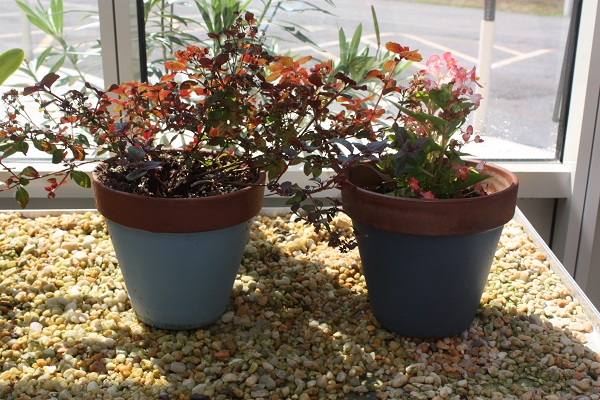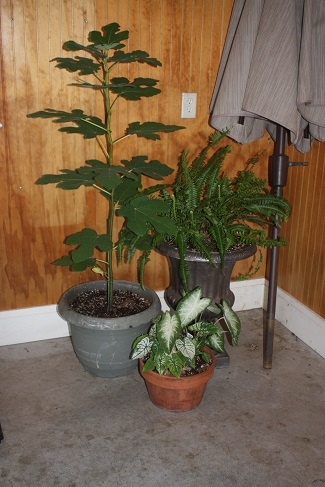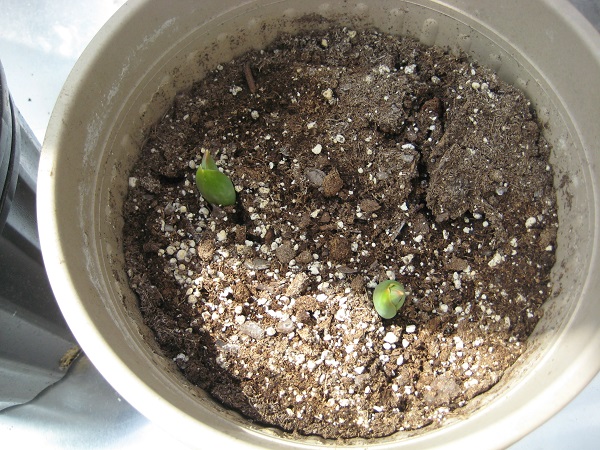Fall is the perfect time of year to play catch up in the greenhouse. The To-Do list becomes a mile long throughout the year. It is always too hot in summer, too cold in winter, and there is too much to do in the spring. Fall is my downtime in the greenhouse, and I turn my attention to everything that needs finished before winter arrives. Early to mid-fall I focus my attention on the greenhouse’s exterior.

There are outside plants which need to come inside and be overwintered. My first frost can come the first week of October, so I like to uproot the plants around this time. By letting the plants feel the drop in temperature, it tells them winter is coming and it is time to go dormant. Summer bulbs, like dahlias and elephant ears need to find a home over winter. If you have a heated greenhouse, do not keep the bulbs in the greenhouse. For most bulbs to sprout in the spring, they need cool temperatures and to be dry. The greenhouse will be too warm and too humid, causing the bulbs to rot. Instead, keep them in an unheated basement or garage. If your greenhouse is not heated, the bulbs will do fine. Any tender flowers you may have had outside should be brought in now as well, such as caladiums and agapanthus.
Do not forget your trees, or bushes that are grown in the soil. Palms, fig trees, tropical hibiscus, and oleanders for example, may not be hardy in your zones. In Pennsylvania, these trees will never survive the harsh winters. You have two options: bring them inside or cover them. The safest way to ensure survival is uprooting the plants and putting them in containers for the winter. However, if the tree is too large for a container, this may not be an option. In this case, you will need to cover it. Wrapping the tree in burlap will help it retain heat. If possible, you may want to consider re-planting the tree near a heated building. The insulated walls will provide the plant with warmth throughout winter. Fall is a good time to replant if it needs to be moved. To even better the chance of your plant surviving you can run a heater to it, or heat strips.

I absolutely love container gardens. I have at least twenty containers full of plants on my patio, and I hate to compost them at the end of summer. If I brought in every plant that was in my containers, I would have no space in the greenhouse. Instead, I take slips and propagate the plants for next year. I always have a lot of geraniums, which will not survive the winter. I break off a piece of the stem and place it in water until it grows roots. After the roots appear, I put the stem in soil, and let the plant grow the rest of the winter. Do not be alarmed if the geranium starts to turn yellow after placing in the soil, it is simply in shock and will grow out of it. I also complete this process with coleuses. As spring arrives you will have a healthy plant ready to be planted in the outside garden again. By raising slips, you save yourself money in the spring and you can keep a plant growing for years. I received a slip of a coleus from my dentist who had a plant which had been growing for close to a hundred years, handed down through the generations! Now that is dedication.
Many of the plants you keep in the greenhouse through winter will need to go dormant. It is important to know a plant’s dormancy requirements, typically measured in hours. The dormancy is mimicking Mother Nature, where a plant stops growing during the cold winter months. Even tropical plants require an off season, where they can rebuild their energy. Do not fertilize and force your plants to grow during the winter months. I made this mistake with a hibiscus plant. I did not understand why the leaves kept turning yellow and falling off the stems. I was so frustrated, and to make matters worse, it got aphids. I was fertilizing and constantly trying to kill the bugs. Well, I finally did some research and found out that a hibiscus should be cut back and allowed to go dormant over winter! My plant was so weak, and I was killing it. As it lost strength, it became the perfect target for the aphids. Amazingly, I kept it alive over winter and it did survive the next summer but only gave me about three flowers. It took her an entire year to recuperate.
Let this be a lesson to you. Research your plant’s needs online, in books and through friends. The greenhouse temperature should typically be in the 30’s for plants who need to fully go dormant, but not much lower or they may die. This is the case with fig trees. They require specific dormant hours, varying between species. If the temperature drops below the 30’s the greenhouse will be too cold, and the tree will not come back the following spring. An unheated greenhouse is best for this temperature range, but, as mentioned, a garage, root cellar, or basement will also work. Other plants will die if the temperature reaches below the 50’s. My geraniums and coleus are kept in the house, as they cannot handle the cold temperatures. Each plant has a specific need, and this is the key to having plants survive into spring.
Now that your plants are safe inside, you can add to your exterior landscaping. Fall is the time to plant bulbs for the spring. Get your snow drops, hyacinths, and alliums in the ground for spring growth. I continue to plant both perennials and bulbs into November, before the severe frosts hit. It always seems I have a daylily or two that never got planted during the summer, so come October I am still finishing my planting.

The same is true for cold weather crops. You can raise cabbage, carrots, and many other crops during these months. It is too late to raise these plants by seed, but you might get lucky and find small plants at local garden stores. They will need some protection, like a plastic hoop covering. I often doubt whether something will grow, but I still plant it. Gardening is all about experimenting and learning as you go. Do not water the vegetables after the first frost. Keep them under the protection and let them live. You may have to shear away a layer or two of frost bite, but the center of carrots and onions will still be good to harvest.
Another greenhouse activity to complete is the forcing of bulbs. This is a great favorite among gardeners. You do not even need a greenhouse to do this. By forcing bulbs to bloom, you can have flowers during a February snowstorm, up to six weeks before spring. Daffodils and tulips are the most common bulbs to force. I take a 6-8” flowerpot and plant a bulb in it, thoroughly covering the bulb with potting soil. Then I moisten the soil, but not to the point of soaking wet. The containers are placed in a cool, completely dark area – somewhere unheated, and I forget about them. I have windows or heat everywhere, so I put my bulb in a solid blue plastic storage container and place the box in the garage. In January check on the containers, and you should find a plant beginning to grow. At this time, bring the flowerpot into the house, put it on a southern exposure windowsill, and start watering it. Soon enough you will have spring blossoms.
One of my other fall activities is painting flowerpots. I cannot stand a dull greenhouse. A sea of green is too much for me. I need color and only buy flowerpots that are bright and colorful. However, when I buy a terra cotta pot, it must be painted. This is a great activity to do with children and artistic friends. To avoid buying paint, I use leftover wall paint. One of my friends is very artistically talented and I often trade recipes and babysitting for painted flowerpots.
Seeds are a year-round obsession for me. I do not believe that vegetables and flowers are only for summer. I continually start seeds throughout the year, fall months included, which is possible with a heated greenhouse. Fresh tomatoes in a snowstorm are wonderful. I always recommend that friends do the same. Start whatever vegetables you want. Give it a try. I start planning next year’s garden in the fall. Seeds should be started around February for summer harvests, so fall is the best time to begin researching new plants and varieties.
No matter what you want to do, just give it a try. Even the best gardeners kill plants. I kill at least one plant each month and have been gardening for countless years. Do not hesitate to try something new in your greenhouse. Gardening is a game of exploration, and fall is the perfect down time for a new experiment.
Lyndsey Roth is an experienced gardener and greenhouse grower.
Related Articles & Free Email Newsletter
How to Create a Plan For Your First Greenhouse


Comment here